
COPING WITH WAR
Man of his Word
My Dear Children,
You, the children of today are passing through a terrible period in the world’s history…We, the people of Australia, have cheerfully taken up our part in this struggle to secure for you a way of life more peaceful and happy than is ours today…Now I want you to do your bit for the safety of this wonderful country in which we live.
(John Curtin, September 1942)
The first families in Australia to feel the impact of World War II were those whose sons, fathers or brothers had enlisted or were called into service. Women shouldered extra responsibilities and children faced daily life without their fathers.
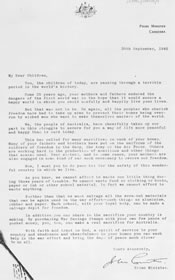
John Curtin Prime Ministerial Library. Records of the Main Roads Department, Western Australia. Circular letter sent by John Curtin to Australian schoolchildren 30 September 1942. JCPML00026
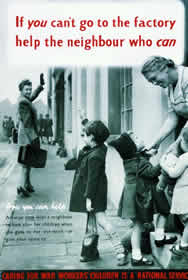
‘If you can’t go to the factory, help the neighbour who can’ poster. Artist unknown.
Courtesy Australian War Memorial: Accession No. ARTV01970
Latch key kids
It was difficult for married women with families to combine war work with childcare. A major problem was ‘latchkey kids’ left to fend for themselves after school. In a Sydney survey of 38 schools, over 3,000 children went home to empty houses or roamed the streets until their mothers came home. In other cases children of six or younger were left alone in locked houses during the day.
The Child Care Committee’s attempts to organise better child care facilities were frustrated by lack of funds. In 1944 there were 70 child care centres in Perth. This was far from sufficient, and grandparents and neighbours were often called on to look after children.
Wartime schooling
At school, children dug trenches and prepared classrooms and themselves for the possibility of air raids. Some were evacuated from schools for safety reasons or relocated because school buildings were requisitioned to house increasing numbers of service personnel.
Every kid had to hang a cloth bag around his or her neck, stocked with a lump of cheese, a packet of raisins, a bandage, and a cork for between the teeth in the event of bombardment…We were stuck with them from dawn to dusk, but I don’t recall their getting in the way of football and friendly fights and the like. And I was strangely untempted to pinch any of the edibles.
(Doug Buckley, 1995)
Children did their bit for the war effort too – knitting, collecting recyclable materials like rubber and paper, and doing without new toys or clothes.
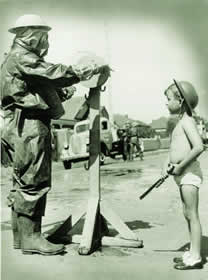
Young Anthony Phillips talking with the Air Raid Precautions (ARP) man.
Courtesy Argus Newspaper Collection of Photographs, State Library of Victoria: Accession No. H99.201/3713
Many children’s toys during the war were home-made or else household items that children ‘made do’ with because materials were scarce and the priority was on essential wartime production. These items are examples of what children used to entertain themselves during World War II.
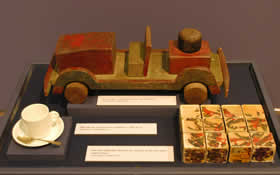
Home-made fire engine constructed from wood off-cuts, white coffee cup and saucer used as a substitute for a child’s tea set
and home-made building blocks which have been covered on all sides with coloured magazine pictures
Courtesy Museum of Childhood: 89.156b, 89.159a-c and 914.3a-t
These toys reflect the growing prosperity of Australian families and the diversity of consumer items available after World War II.

Doll’s tea set c.1950, toy picnic set made of plastic c.1950, 'Bayko' boxed building set containing multiple plastic components and metal joining rods with an accompanying instruction manual c.1950, ‘Pedigree’ baby doll made of plastic with articulated head and limbs and moving blue eyes, c.1950 and The New Annual of Modern Marvels c.1950.
Courtesy Museum of Childhood: 9479.13a-k, 9479.15a-q, 9810.1a-m 9810.2 9810.3a-b 9810.2a-b 9810.4a-c, 9472.1 and B89001.3.
HOME SWEET HOME
Shortly after the war there was a housing shortage estimated at 250,000 to 300,000 homes due to the lack of materials and skilled labour. Since 1943 the Commonwealth Housing Commission had been investigating ways to provide adequate housing. From the late 1940s home ownership became the great Australian dream.
The War Service Homes Scheme built houses for ex-service personnel. In Western Australia two purchase options were available. One was a rent-purchase scheme which required a deposit of 5% for a land and house package. The other depended on obtaining a loan from the Scheme to buy or build a house. New estates were concentrated around Floreat Park, Scarborough, South Perth, Applecross, Manning, Victoria Park, Doubleview, Mt Pleasant, Hilton and Yokine.
Modern designs tended to be simple and utilitarian not only because of lack of materials or money but also because until 1952 house size was limited by legislation. By 1954 most Australian homes had only five rooms, but the bathroom had moved indoors and there was space for the family car in the yard.
A Cottesloe Cottage
Despite his official home being at the Lodge in Canberra, Curtin’s heart remained with his family in the beachside suburb of Cottesloe. During the 1940s concerts and talent quests were held below the Cottesloe promenade with audiences often joining in the sing-a-longs to such favourites as By the light of the silvery moon and Let me call you sweetheart. On Saturday and Wednesday nights a band would play at the Palais de Dance. Beach goers could visit the Astoria Tearooms or line up at the kiosks to purchase slices of watermelon and ice creams.

House plans from Workers Homes Board.
Courtesy State Records Office of Western Australia: WAS 1381 AN 150
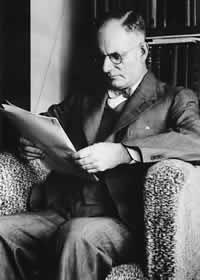
John Curtin reading in his favourite seat at home c.1942
John Curtin Prime Ministerial Library. Records of the Curtin family. John Curtin reading c.1942. JCPML00381/33